Restoring the One-Eyed with Blinkers On: The Curious Case of Marlon Brando’s Muddled Apprenticepiece
posted August 24, 2016 1 Comment
![]()
By Peter Monaghan
n
Marlon Brando directed only one film, and that came about, in 1961, only because he and a young Stanley Kubrick, whom Brando had hoped would direct, arrived at “creative differences” so Brando decided he would take on the job.
n
Now the film, One-Eyed Jacks, has received a state-of-the-art restoration by NBCUniversal in collaboration with The Film Foundation, supervised by two filmmakers who had long pressed for its revival, Martin Scorsese and Steven Spielberg. The latter has called One-Eyed Jacks “one of my favorite westerns,” just as Brando called it, in his 1994 autobiography, Songs My Mother Taught Me, “one of my favorite pictures.”
The restoration has been doing the festival circuit, and Criterion Collection will issue home-video packages on DVD and Blu-ray, late in 2016. Admirers have for years generally had to view the film in sub-standard copies, so the new release presumably will only boost the cult status of One-Eyed Jacks, which has stemmed from the film’s oblique take on Hollywood genre conventions, and from its faithful followers’ considering it psychologically compelling and visually memorable.
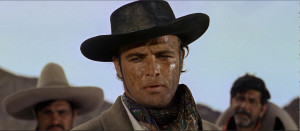 Adding to its esteem has been that it was the last American film shot in the high-resolution, wide- screen VistaVision format that Paramount engineers crafted in 1954. (Some European and Japanese features continued to use it, as did some American studios when creating high-resolution special-effects sequences.)
Adding to its esteem has been that it was the last American film shot in the high-resolution, wide- screen VistaVision format that Paramount engineers crafted in 1954. (Some European and Japanese features continued to use it, as did some American studios when creating high-resolution special-effects sequences.)
Brando plays the outlaw, Rio, whom fellow crim Dad Longworth (Karl Malden) leaves in a lurch as they flee Mexican rurales (mounties) with saddlebags of stolen bank gold. The law dumps Rio in a brutal, rat-infested prison, and it takes him five years to break out – implausibly so, given his Houdiniesque flights from hoosegows, thereafter, along with his Phoenix-like… hell, Christ-Lite resurrections from beatings. He sets out to find Dad and finds him in the town of Monterey on a wave-pounded California coastline. There, the crook has transformed himself into a tough sheriff and covetous, condescending head of family with a Mexican woman (Katy Jurado, best known for High Noon) and her stepdaughter, Louisa (Pina Pellicer, who won Best Actress at the San Sebastian Film Festival for her performance). Louisa weirdly rapidly and certainly unwisely falls for the ego-fractured Rio.
Trouble ensues, as it will.
A typical claim for the film’s accomplishment came in Town Topics, a weekly newspaper in Princeton, New Jersey (for whose connection to the film, see below). “The voice Brando develops for his character Rio, aka the Kid,” said Town Topics, “has in it the distilled essence of every cowboy hero every kid who grew up in westerns has absorbed into the depths of his or her Saturday matinee soul. The fascination of Rio’s voice is in its subtle, plaintive, sometimes barely audible inflections, the way it lilts, slurs, and simmers as Brando makes it express his quiet, lonely, pathological quest for vengeance.”
So captivating is the performance, and the film, over all, Town Topics said, that it became “one of those compulsively quotable movies, so crazed and quirky, so rich in style, detail, and language, mood, and movement, that people who ‘know it by heart’ take it into their lives to the point where kindred spirits recognize one another whenever their paths cross.”
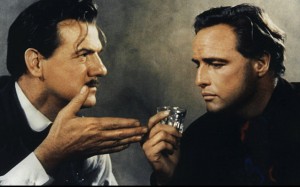
Dad Longworth (Karl Malden) tries to throw sand in Rio’s eyes
That the film was ever made is testimony to Brando’s investment in it. Its birth was complicated, and involved several hands — so much so that the results bring to mind the old joke about a camel being a horse designed by a committee.
Brando apparently went into the project with a confused conception of what he wanted. He had at first thought of working from Alexander Dumas’s revenge classic, The Count of Monte Cristo, but then had settled on The Authentic Death of Hendry Jones, a 1956 novelization of the life of Billy the Kid by Charles Neider, a Mark Twain authority at Princeton University. Film producer Frank P. Rosenberg had Rod Serling, renowned for The Twilight Zone series, write a screen adaptation. Rosenberg rejected that script, and hired Sam Peckinpah to write another, which the budding revisionary western director completed late in 1957. Brando didn’t like either Peckinpah effort, so let him go.
As a confirmed Hollywood and Broadway star, Brando had cause to imagine he knew what he wanted, even if his selection of Neider’s novel was apparently ambivalent. His nascent Pennebaker Productions had paid $40,000 for the rights to the book, which the New York Times had called “an excellent dramatization of the myths that circulate around the deeds of bygone gunmen.” Originally Brando wanted Stanley Kubrick to direct a film based on it. But then Brando replaced Peckinpah with Calder Willingham, who had gained renown for his sly, black-comic novels, and had in 1957 gained screenplay credits on an adventure epic and Kirk Douglas vehicle, The Vikings, as well as Paths of Glory, Kubrick’s film about the prosecution of questionable charges of cowardice against French soldiers in World War I. Later Willingham would gain further credits for Mike Nichols’s The Graduate (1967), although contentiously, and for Arthur Penn’s Little Big Man (1970) and several other films. He also saved Vladimir Nabokov from an unhappy teaching gig at Cornell University by passing along a copy of Lolita to Kubrick, leading to screen adaptation. (Upon his death, the New York Times wrote of Willingham: “Once described by [Norman] Mailer as ‘a clown with the bite of a ferret,’ Mr. Willingham specialized in acerbic, comic fiction that shied away from neither sexual explicitness nor Southern Gothic excess.”)
{Click on an image to expand}
Paramount publicity stills from the original release, 1961.
Willingham considered himself, whenever in Hollywood, as merely a pen-for-hire, but that approach didn’t work with Brando: they labored together on a script for One-Eyed Jacks but it came to little, and Brando responded by letting go of both Willingham and Kubrick. Kubrick hadn’t been happy with Willingham’s ideas for the film, either, and he and Brando “repeatedly clashed over the issue of character development,” according to an account for Turner Classic Movies. “It’s probably safe to assume that Brando wanted more and Kubrick less,” Mark Frankel says, “but things finally came to a head when Brando overheard Kubrick making a crack about an actress Brando was smitten with. Kubrick was immediately fired, though the official press release stated that he had resigned to work on Lolita.”
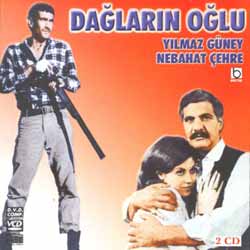 That all led Brando to hire Guy Trosper, who until that point was known for writing two baseball movies — The Stratton Story in 1949 which had starred James Stewart, and The Pride of St. Louis in 1952, which drew an Oscars nomination — and the execrable 1957 Elvis Presley star turn, Jailhouse Rock. (Curiously, the Willingham script of One-Eyed Jacks that Trosper completed was adapted by Bülent Oran in 1965 for a Turkish bandit potboiler, Daglarin Oglu (“Son of the Mountain”), by the prolific Yilmaz Atadeniz. (You’d hardly credit it, but an atrocious copy is on YouTube.)
That all led Brando to hire Guy Trosper, who until that point was known for writing two baseball movies — The Stratton Story in 1949 which had starred James Stewart, and The Pride of St. Louis in 1952, which drew an Oscars nomination — and the execrable 1957 Elvis Presley star turn, Jailhouse Rock. (Curiously, the Willingham script of One-Eyed Jacks that Trosper completed was adapted by Bülent Oran in 1965 for a Turkish bandit potboiler, Daglarin Oglu (“Son of the Mountain”), by the prolific Yilmaz Atadeniz. (You’d hardly credit it, but an atrocious copy is on YouTube.)
Brando said later that once he took over as director, he and Trosper “constantly improvised and rewrote between shots and setups, often hour by hour, sometimes minute by minute,” even as filming proceeded. Fans of the results point to various skills Brando exhibited, but control of the shoot was not among those. It dragged on and on in part because Brando knew little about directing but was wedded to the “method acting” that he espoused but that ill served the project, and in part because he was exceedingly exacting in a way only fully self-convinced auteurs must be, or will. He wanted control not only over his crew but even over the way waves rolled onto the Pacific shore. He shot six times as much film as originally envisaged, which took twice the planned 12 weeks, and more than three times the $1.8-million budget.
To do justice to the camera work of the veteran Charles Lang, who received an Academy Award nomination for best cinematographer/color for his expressive filming of the Mexican desert and the California coast, NBCUniversal and The Film Foundation digitally scanned original 35mm VistaVision negatives in 6K to produce a 4K restoration. Paramount kept the original negatives in its vaults, but the blue hues of the original Eastman 5248 color film stock had faded. The restoration, done at NBCUniversal StudioPost, with some digital restoration at Prasad, required laboriously recreating all but the blues.
For Universal Pictures, One-Eyed Jacks is about the thirtieth project it has completed since announcing a restoration agenda during Universal’s centennial in 2012; among them has been another iconic western, Clint Eastwood’s High Plains Drifter. The company plans another 25 releases during the next year or so. In 2015, it announced a silent-film initiative in which it will restore about 15 films from its first decades, including murder drama The Last Warning, Oh Doctor starring Reginald Denny and Mary Astor, Tod Browning’s Outside the Law, and Sensation Seekers, about a “man of God” who falls in love with a “jazz-crazed butterfly.”
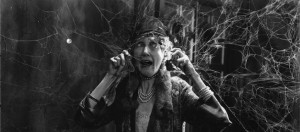
“Last Warning,” 1929.
Universal’s partner in the One-Eyed Jacks project, The Film Foundation, is a nonprofit organization that Martin Scorsese set up in 1990 to promote film history and preservation. It has worked with archives and studios to restore almost 700 films.
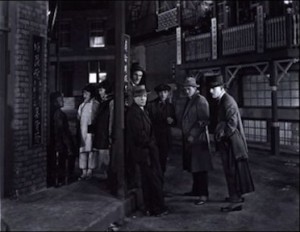
“Outside the Law,” 1920.
One-Eyed Jacks‘ reception has been curious. Filmmaker Peter Bogdanovich told Indiewire it was “the last time Brando acted out of true commitment, an uncynical passion for the material,” and that he gave “one of his best performances… His direction is perceptive and effective — all the actors are uniformly excellent.”
The film has impressed some critics, too. In Time Out, Tom Milne said it “smoulders in a manner that is mean, moody, and magnificent,” and he identified aspects of it that at the least provide fodder for critical reverie: “The Freudian intentions lurking in the character conflicts and the card symbolism, the homosexual and Oedipal intimations, are underpinned by the extraordinary settings.”
Milne also allowed, however, that One-Eyed Jacks was a bit of a mess, and he pointed to one fount of the confusion, the psychological complexities that Brando had grappled to inject into his characters, when he wrote: “The result, laced with some fine traditional sequences and stretches of masochistic violence, is a Western of remarkable though sometimes muddled power.”
“Muddled,” isn’t wrong. Even Brando, despite expressing great affection for the film, said: “I don’t feel it’s what I set out to do.” In his conception, the characterization was to have been far more nuanced, he said, but “now the characters in the film are black and white, not gray and human as I planned them.”
He claimed that he wanted to make a “frontal assault on the temple of clichés.” For all that, plenty of reviewers found the results hackneyed. Time magazine, for instance, called the movie “a horse opera” and “the usual melodrama of revenge.”
That was only half the story. As Bosley Crowther wrote in a 1961 New York Times review, the movie displayed “two contrasting styles. One is hard and realistic; the other is romantic and lush. All the way through it runs a jangle of artistic ambivalence.”
The “rugged realism,” “blunt and credible,” included the treachery that “has the grimy, smelly aura of a double-cross down by the city dump” and the vengeance that draws two men through “a strong wave of noxious vapor” to an “inevitable showdown” in a town square “cold and damp.” Crowther writes: “These moments have been directed and played with the kind of vicious style that Mr. Brando has put into so many of his skulking, scabrous roles. Realism is redolent in them.”
It’s when Brando the director sought to ladle nuance into his characters that his conventional, albeit better-than-average execution of a cowboy revenge plot turns rapidly to schmaltz. As dashing-blade (aka serial sexual snake and assaulter) Rio courts Dad’s incoherently characterized stepdaughter, he exhibits a confusion of revenge, desire, and inadequacy. That might sound like the makings of a compelling character, but watch the film and you’ll quickly see that Brando was unable to find his way to clarity about what he intended, so he resorted to dolloping on a pastiche of fresh intuitions and received matinee tropes, including such homely fictions as that a bad or sad man might be saved by the love of a good woman.
You won’t quite be mesmerized into overlooking these inconsistencies, as much as you’re lifted by the insipid welling of strings in Hugo Friedhofer’s score, which One-Eyed Jacks cultists nonetheless persist in applauding.
Crowther in the New York Times reported much of this in 1961 when he said the showdown adventure wallows in “element of creamed-cliché romance and a kind of pictorial extravagance that you usually see in South Sea island films.” The winsome Mexican miss, deflowered by deceit during a cutaway. Her fine-self-improving-impoverished-woman Mexican mother, unable to make a good man of dastardly Dad.
“It is an oddity of this film,” a Variety review held, “that both its strength and its weakness lie in the area of characterization. Brando’s concept calls, above all, for depth of character, for human figures endowed with overlapping good and bad sides to their nature.” Instead, the release of a restored One-Eyed Jacks brings into sharper focus that Brando was unable to separate his own psychology from what his characters’ might have been. Dave Kehr in Chicago Reader observed: “The most memorable scenes have a fierce masochistic intensity, as if Brando were taking the opportunity to punish himself for some unknown crime.”
A standard riff among champions of One-Eyed Jacks is that Paramount foiled Brando’s grand conception. In the record of tussle between auteur and studio executives, they have no trouble finding reasons to flatter their idol. Brando wanted Paramount to take a 4-hour-42-minute cut to the cinemas – the cut he had reduced his original eight hours to, under studio pressure – but Paramount, already perturbed at how over budget the production was, managed to pare him back to 141 minutes, fully one-half his preferred length. Paramount did that by, for example, losing sequences in the Sonoro prison where Rio nurtured his thirst for revenge.
Perhaps even worse for Brando’s pride and joy was that Paramount insisted on the usual: a “happy ending.” The one they came up with, and filmed after the initial shoot, is hardly coherent. It might be sappy; it might be ludicrous; it might even hint in directions Brando might have.

Brando with Pina Pellicer, who played Louisa, the naïve object of Rio’s disheveled ego and eros.
The studio got its misbegotten way after wearing Brando down to the point he walked away and left the final editing to others. Long after, when Newsweek asked him about One-Eyed Jacks, he said: “Any pretension I’ve had sometimes of being artistic is now just a long, chilly hope.” Malden claimed: “If we’d made it the way Marlon wanted it made, like a Greek tragedy, it could have been a breakthrough western. It could have been a classic.”
It was, as it turned out, not even a box-office hit; far from it.
Journalists, famously averse to editors cutting their golden words, might sympathize with actual creators in the arts whose work meets fates like Brando did, with One-Eyed Jacks. But, judging by what we see in the film, and can glean from Brando biographies and autobiographies, his grappling with his characters’ psychology would not likely have been resolved if he had had free rein to explore and develop it during the hours’ more running time he had sought.
In his own mind — not, almost certainly, in any apparently lost cut footage — were locked the opportunities lost. Strip away the allowances that contemporary convention accorded the western, and that westerns still in some quarters enjoy, and what’s left is a dog’s dinner of implausible action, spit-thin sentimentality, soap-opera melodrama, genre cliché, man-toy shoot-’em-up, and the susceptibility of women so credulous and compliant only a damn-fool man could make them up.
Obviously the executives and filmmakers behind this restoration wouldn’t agree with much of this — with its premises — so it’s perhaps superfluous to ask what the point of a restoration might be, in a case like this.
To experience more sharply the artistry of the filming, and the many poignant, arresting, or captivating moments Brando did achieve, certainly.
To be presented more sharply with how flawed his creation was? Yes, or no.
Previous Post: Nitrate Film to Light Up the Egyptian Again
Next Post: The System that Does or Does Not Prevent Online Posting of Copyrighted Moving Images

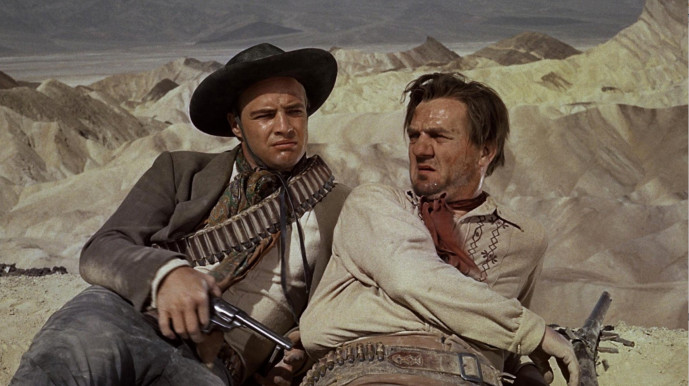
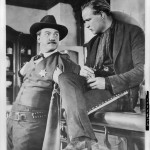
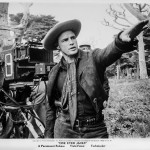

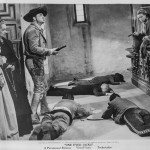


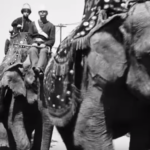
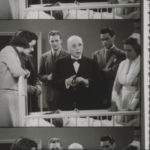

Considering Brando wanted to make this a 3 hour movie and it was cut by the movie company, Brando did a very good job. The end result does seemed rushed, as the storyline gets confusing. This wasn’t Marlon’s fault. I can’t blame him for not wanting to direct again. Still a good movie, all the same!